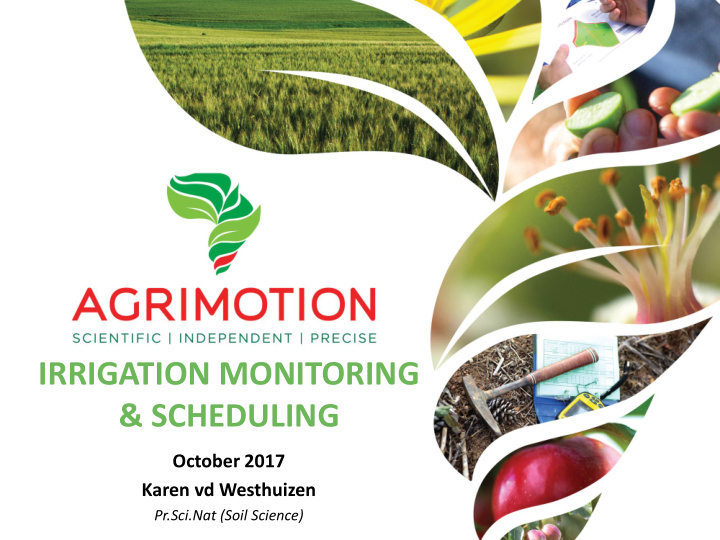



IRRIGATION MONITORING & SCHEDULING October 2017 Karen vd Westhuizen Pr.Sci.Nat (Soil Science)
1 SOIL PROPERTIES Total Available Water START irrigation 50% STOP 40% irrigation 60% Field Capacity PWP Saturated Dry Irrigation is the manipulation of the oxygen and water ratio in the soil
2 SOIL PROPERTIES • The effective soil depth (limiting layers) • Effective rooting depth (70-80% of roots) • Volume of soil to irrigate height width length
3 SOIL MOISTURE CAPACITANCE PROBES • Continuous data logging for temporal variation in soil moisture • Sensors at multiple depths • Data collected using: radio, hand logger, GPRS, Wi-Fi 2 sensors
Soil differences 4 SOIL MOISTURE PROBES • Probe placement is crucial • Ensure emitter is functioning Sand Clay • Representative position within block • Representative plant • In root zone to see water extraction • In wetted zone to see when irrigation water applied Clay Sand
5 INTERPRETING PROBE GRAPHS Depth graphs Cooler Hotter Period period (3 days) (1 day) Root zone 0-40cm Buffer zone Buffer zone 40-80cm
6 SETTING GRAPH LINES ON SUM GRAPH • Step 1: Set root zone depth – Do a field observation – Look at depth graphs 30cm root zone 40cm root zone
7 SETTING GRAPH LINES ON SUM GRAPH • Step 2: Setting upper line – Find drainage spike at EACH depth within the root zone – Field capacity Set upper line
8 SETTING GRAPH LINES ON SUM GRAPH • Step 3: Setting lower line – Find stress point at EACH depth within the root zone – 50% of total available water Set lower line
9 SETTING GRAPH LINES ON SUM GRAPH • Step 4: Setting cultivar line – Set manually depending on the phenological dates & strategies followed 40% 50% 70% Wine Grapes: Bud Flowering Veraison harvest Leaf drop Pea size break & set Root activity Cell division Cell enlargement Shoot growth Post harvest Dormancy Berry ripening begins 70-80% 40-50% 70 – 80% 50% 70 - 80%
10 HOW LONG TO IRRIGATE? Irrigation duration • Soil textures vary with deep drainage & runoff • Select the correct emitter delivery Sandy Loam Clay Loam Rapid Infiltration Slow Infiltration runoff may result deep drainage may result
11 WHEN TO IRRIGATE? Irrigation frequency • Soil textures hold & supply varying amounts of water • Need for irrigation breaks • Check field observations & probes • Weather & crop dependant x x x x More frequently Sand in smaller quantities 3x x 3x 3x Loam Less frequently Irrigation = ET o x CF x 10 in larger quantities
Field Capacity ( 0%) 12 Cultivar line (4 0%) Refill point (5 0%) 40% Refill 50% 0% Permanent wilting point Field Capacity 100% Saturated Dry 1 2 3 4 5
Field Capacity ( 0%) 13 Cultivar line (4 0%) Refill point (5 0%) 40% Refill 50% 0% Permanent wilting point Field Capacity 100% Saturated Dry 1 2 3 4 5
Field Capacity ( 0%) 14 Cultivar line (4 0%) Refill point (5 0%) Stress 40% starts 50% 0% Permanent wilting point Field Capacity 100% Saturated Dry 1 2 3 4 5
Field Capacity ( 0%) 15 Cultivar line (4 0%) Refill point (5 0%) Refill Point Stress 40% starts 50% 0% Permanent wilting point Field Capacity 100% Saturated Dry 1 2 3 4 5
Field Capacity ( 0%) 16 Cultivar line (4 0%) Refill point (5 0%) Stress 40% starts 50% 0% Permanent wilting point Field Capacity 100% Saturated Dry 1 2 3 4 5
Field Capacity ( 0%) 17 Cultivar line (4 0%) Refill point (5 0%) Stress 40% starts 50% 0% Permanent wilting point Field Capacity 100% Saturated Dry 1 2 3 4 5
Karen vd Westhuizen Pr.Sci.Nat (Soil Science) 7
Recommend
More recommend